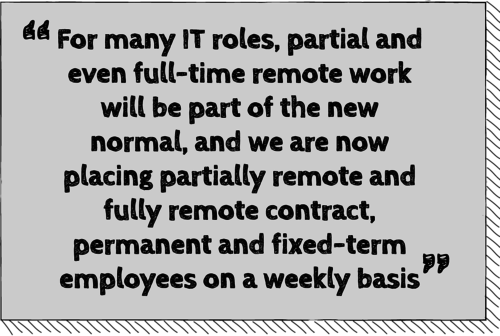The impact of COVID-19 on New Zealand businesses has been wildly uneven. New Zealand has fared well but sadly

has not been spared from the economic impact. While many companies have found it exceptionally difficult during this period, there are a considerable number of organisations who have never had it so good. The IT sector, for example, has done much better than other white-collar sectors and will have continued job growth, but still faces its own unique challenges in this economy. Across the board, COVID-19 has had a significant impact on employment and recruitment practices, and it’s becoming clear that things won’t go back to the way they were.
As a seasoned recruitment professional specialising in Technology, Transformation and Digital roles, I have seen a number of opportunities and obstacles beginning to emerge for IT recruitment in New Zealand’s current economy. The availability of local talent, the expectations of candidates regarding remote and flexible working, and what your competitors are offering potential new hires have all changed radically.
Whether you are hiring as per usual, facing a hiring freeze or facing an increase in hiring, you will likely need to revise your recruitment strategy to fit with the rapidly changing market brought about by COVID-19. Here’s what you need to know to secure the best talent in this new era:
Widening Skills Shortages
We explored the New Zealand IT sector’s skills shortage prior to COVID-19 in an earlier blog, where we determined that New Zealand has a significant and growing skill-shortage in this sector. Before COVID-19, we had around 5000 immigrants coming to New Zealand each year on IT-related work visas, and with borders shut, the shortage has widened.
Many media outlets have painted the picture of a “brain-gain” for New Zealand with returning Kiwis, but the reality is that many of these highly skilled people who have pursued careers overseas have done so in order to engage with industries or technologies that just aren’t mature in New Zealand, so they are returning with skills that are often not a good match for the vacancies available. This gap puts significant pressure on businesses to attract and retain skilled IT professionals and calls for them to rethink their recruitment strategies.
Initially, some businesses in the regions benefitted tremendously from being some of the first employers to kick off massive recruitment drives, snapping up highly skilled individuals who had been working for businesses heavily impacted by COVID-19. Some of the most successful recruitment drives were seen during the height of Level 4 in the Waikato, with an overwhelming number of IT Managers reporting they had never seen such a volume of high calibre talent actively looking for work and keen to relocate to the region, filling vacancies in record times. However, as we now enter one of the busiest times of the year for recruitment, this hiring frenzy has been replaced by fierce competition for a shrinking talent pool and employers are growing increasingly more creative and flexible to attract the skills they need to keep moving forward.
The Rise in Remote/Partially Remote Working
To cope with the uncertain economic climate and skills shortage, organisations will need to become more open to working with remote and partially remote workers. Because of COVID-19, recruitment strategies are pivoting to focus on hiring candidates for flexible roles that can also be done from home. Previously, I would often be contacted by high-calibre remote contractors asking me to keep them informed of any opportunities to work remotely, and I would tell them honestly that these types of roles were rare. Candidates not available for full-time onsite work were almost never shortlisted by my clients for interviews.

For many IT roles, partial and even full-time remote work will be part of the new normal, and we are now placing partially remote and fully remote contract, permanent and fixed-term employees on a weekly basis. There are long-term benefits to having a more flexible workforce that will last well after this period is over. Flexible jobs help diversify teams by keeping parents – especially women – in leadership roles. Shifting to a more flexible workforce can also help companies save money by only paying people for the work needed at the moment during these turbulent times and beyond.
The Growing Popularity of Contract and Temporary Workers
The rise in remote, flexible, and temporary work is not only due to the growing demand from the candidate market. Unsurprisingly, many of the country’s top employers are responding to the financial challenges of COVID-19 by focusing on cost-saving measures. A big part of this is opting for temporary or contract workers to augment their professional teams. This will give them access to the experience and skills they require, without the high investments that come with recruiting and training permanent employees.
There’s no question that opting for contractors and temporary staff will result in cost and time efficiency, as well as supplementing necessary skill sets. While temp staff can fill an immediate need at short notice, contractors are often skilled, specialised workers and could give your company high-level expertise without you having to commit to a large salary and recruitment and training costs. Contractors are great for assisting with a spike of work or for supporting a specific project – for example, a contractor might provide software development expertise to increase your business’ digitisation or improve your e-commerce platform.
These types of workers allow your business to scale up and down without the risks and obligations associated with a permanent hire. In addition, employers are also able to enjoy access to world-class talent that may not be available to them on a full-time, onsite basis.
As organisations attempt to build blended, flexible workforces, contracting and temp work will expand to new industries and role types. And while there is no one-size-fits-all solution around alternative work arrangements, employers will need to update their policies if they’re going to attract and retain staff with hard-to-find skills.
Attracting Top Talent with Your Employer Brand
The key thing to remember when hiring any kind of worker is that while you are interviewing them (and they are interviewing you), they are also interviewing with other companies. If you’re hiring anyone with a senior or niche IT skillset, you can safely assume that you aren’t the only company vying for their attention. And while you can’t control who else the candidate is interviewing with or what those companies are offering, you can strengthen your own employer brand.
As the country began to recover, more businesses started recruiting and competition has grown fierce, with the focus shifting from the dream-candidates who initially hit the market due to redundancies, to a fierce battle for the passive candidate market. Passive candidates don’t engage the same way as active candidates, their motivators and hesitations are different, they don’t negotiate the same and they don’t have the same level of commitment to the interview process.
This means that what companies are offering needs to be enticing and compelling, and recruitment processes need to be flexible and efficient. Passive candidates, or those who are headhunted, will shy away from businesses with a poor employer brand or companies that they perceive to be at risk for restructuring, particularly if they are currently in a stable role.
Many in-demand candidates are doing their research and speaking to their network before they’ll agree to go to the first interview, and sometimes even right up to the offer stage. To make yourself more attractive as an employer, try to offer as much job security as you can. Be honest and treat people well. Your business recovery and future growth are still reliant on your team’s performance and your reputation in the market. Your current staff, past staff and your job applicants can have a major impact on how desirable an employer you are perceived to be.
The Candidate Experience
To maintain your reputation in the employment market, it is essential that you provide a great candidate experience and ensure that anyone rejected from the process leaves with the feeling of “Gosh, I really wanted that job. What a great company it would be to work for.” Providing a great candidate experience is the key to attracting the best people.

How do you know if you’re providing a great candidate experience? Look to your offer acceptance rate for an answer. Your offer acceptance rate is one of the best indicators that your recruitment experience is meeting candidate expectations. Maintaining a positive experience throughout and setting clear expectations from the outset is crucial for closing the deal and convincing a candidate to accept your offer.
Likewise, a long, drawn-out recruitment process will put candidates off. If they’ve been headhunted, they might not be willing to take three days off work for three separate interviews and travel across town to meet you in person. Luckily, employers and candidates alike have had a crash course in video interviewing and are becoming increasingly comfortable with conducting the process remotely. This allows employers to streamline their process and interview many more candidates in a shorter space of time, meaning they can make decisions faster and secure the talent they want ahead of their competitors.
In Summary
Access to talent and looking after your employer brand has never been more important than it is today. Be sure your recruitment partners are invested in protecting your employer brand and share your values around giving a good candidate experience. By adapting to the market and making these things a priority, you will be in the best position to secure the people you need.
If you’re looking for high-quality Technology, Transformation and Digital talent, feel free to reach out to me – I’d be happy to help you find the people your business needs during this time.





